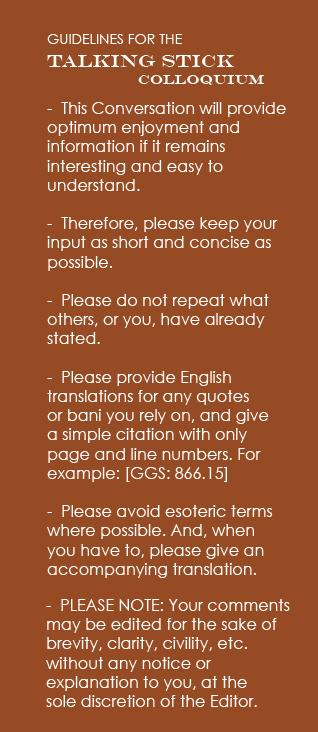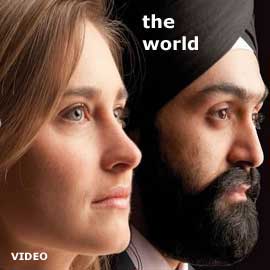Columnists
Kirtan Sohela
The Talking Stick Collquium XXI, Stanza One, May 24 - 30
Convenor: RAVINDER SINGH TANEJA
Kirtan Sohela
We take a leap this week from the Japji to Kirtan Sohela. In the Japji, we were reminded to go about the business of life in a disciplined, creative and purposeful way while remaining grounded in Hukam with patience, restraint, knowledge and love.
Sohela, to which we now turn, is a short prayer consisting of five stanzas and is meant to be recited before retiring for the night - as we prepare to transition from a state of wakefulness during the day to slumber during the night.
In the scheme of the Guru Granth Sahib, Sohela is placed after portions of the evening bani, "So Dar" and "So Purakh," which are recited at dusk as part of "Rehraas Sahib." Bhai Gurdas testifies to the long established tradition of reciting Sohela after "So Dar."
The term Sohila refers to celebratory songs that are customarily sung during joyous occasions, but more particularly to mark a marriage. In the days leading to the wedding, friends and relatives of the bride gather to give the bride a makeover which involves, among other things, pouring of perfumed oil on the bride's head.
At the same time, songs of sadness and songs of happiness are sung: to ease the pangs of separation from family and familiar surroundings; to provide assurance and instruction on dealing with the transition of traveling to a new home and establishing new bonds.
Sohela, or Kirtan Sohela as it is commonly called now, prepares us to disengage from worldly activity, to retreat and reflect, and above all, to give thanks for all that was given and received in our daily sojourn.
THE MESSAGEIn the first stanza of the Sohela, Guru Nanak uses the analogy of a wedding ritual to prepare us for that final consummation - Death. Transition to the other side fills us with fear and anxiety, just as a young bride is likely to be filled with these emotions at the prospect of leaving her known world.
But the bride is also full of anticipation at the prospect of a new life with her husband.
Mortals, on the other hand, are simply terrified at the prospect of Death.
Here Guru Nanak offers solace and instructs on how to cope with Death - which can be an opportunity of union and eternal life - if only we could grasp the moment.
His advice: In sangat, celebrate life, mindful of the Creator who sustains all of us with gifts so numerous as to be beyond all reckoning. Meditate on the fearless One and thus cultivate fearlessness.
Death is inevitable, for the appointed time is already written. Prepare for it by anointing yourself with the oil of remembrance. Seek the blessings of friends and the forgiveness of those you may hurt, so that you may travel to meet your Maker with joyful anticipation.
The call of Death is upon each one of us; its reminders are all around. Be prepared for the inevitable by being constantly aware of the One who sends the Grim Reaper to fetch us.
LET'S CONSIDER:
Interestingly enough, Sohela is also recited during a Sikh funeral. (In common Punjabi parlance, to say that someone's "Sohela has been recited" has the connotation that he has died or has been killed.)
Death, in Guru Nanak's view, is not the dreadful event that we perceive it to be. Rather, it is a moment pregnant with immense potential, if only we grasp it as the doorway to our Eternal home.
Is our fear - and dread - of Death misplaced?
Let's talk about it.
THE TEXT - Rendered in English
SohilÄ rÄg gaurheer deepkee mÄ—hlÄ 1
Song of Joy in the Rag Gaurhee, Deepkee, First Nanak
Ik oaʼnkÄr saṯgur parsÄá¸
The One Creator realized through Grace
Jai gẖar kÄ«raṯ Äkẖīai karṯe kÄ hoe bÄ«cẖÄro
Where praise is given and the Creator meditated upon
Ŧiṯ gẖar gÄvhu sohilÄ sivrihu sirjaṇhÄro.
Come hither and sing the ode of joy ||1||
Ŧum gÄvhu mere nirbẖao kÄ sohilÄ.
Sing paeans to that fearless One
Hao vÄrÄ« jiṯ sohilai saá¸Ä sukẖ hoe.
I'd offer myself up to hear that song of eternal bliss.||1||
RahÄo// Pause
Niṯ niṯ jÄ«aá¹›e samÄlÄ«an á¸ekẖaigÄ á¸evaṇhÄr
The One whose watch sustains all creation will tend to us as well
Ŧere á¸Änai kÄ«maṯ nÄ pavai ṯis á¸Äṯe kavaṇ sumÄr.
Gifts beyond measure, we cannot keep count ||2||
Sambaṯ sÄhÄ likẖiÄ mil kar pÄvhu ṯel.
The wedding day is fixed, come anoint me
Deh sajaṇ asÄ«sá¹›Ä«Ä jio hovai sÄhib sio mel.
And wish me union with the Maker, O friends. ||3||
Gẖar gẖar eho pÄhucáº–Ä saá¸á¹›e niṯ pavann
The call goes out to everyone, no one is immune
Saá¸aṇhÄrÄ simrÄ«ai NÄnak se á¸ih Ävann.
Forever remember the One who summons, the Day is sure to come||4||1||
Conversation about this article
1: Pashaura Singh (Riverside, California, U.S.A.), May 24, 2010, 9:53 PM.
The word 'Sohela' literally means 'Song of Separation' and is employed for wedding songs which are sung as the bride leaves her parents' home. In the Guru Granth Sahib, the opening hymn of Kirtan Sohila is set to the mixed melody of Gauri-Dipaki. We must understand the background of creating new raags by the Gurus in their musical performance. Most instructively, Guru Nanak and the succeeding Gurus laid great emphasis on the performance of those ragas that produced a balanced effect on the minds of both listeners and performers. Any raag that aroused passion of any kind was not selected as the carrier of their message. For instance, there are still some musicians who believe that Dipak raag generates fire if correctly performed. Whether it is true or not, this raag is not used independently in the Guru Granth Sahib. It is, however, used as Gauri-Dipaki in a mixed form (sankar raag) so that its extreme effect is toned down. The resulting form is most suitable for the creation of a reflective mood. In particular, Gauri-Dipaki is employed in the opening hymn of the bedtime prayer, Sohela, thereby conjuring up a sense of light that flickers in darkness, of mystery and apprehension (in the context of immanent death, symbolized as a wedding in the text), which is steadied by faith and fearlessness: "When we are gathered to worship our Maker, sing songs of praise and ponder the Name. Sing songs of glory; reflect on the wonder, the wonder of You who created us all. We sing to Your praises, You who are Fearless. Humbly, we bow for the song which brings joy. You who give life are our constant Protector, watching and guarding us safe in Your care. How can we judge all Your goodness and mercies, how grasp the worth of Your marvelous grace?" This early part of the opening hymn assures us with faith and confidence and prepares us for welcoming death as a moment of celebration. Indeed, for a dedicated Sikh (gurmukh) death is a joy to be welcomed, for it means the perfecting of union with Akal Purakh: "You have determined the time for my nuptials; come pour the oil of joy at my door. Bless me, my friends, that I find that sweet union, perfectly joined with our Maker divine." This is a moment of celebration for the gurmukh who has lived his or her life in faith and dignity. For a self-centered person (manmukh), by contrast, death means the culmination of his or her separation from the Divine and perpetuation of the process of reincarnation. In the final verse, Guru Nanak reminds us all of the inevitability of death: "All must receive their last call to depart, from various households each day some must go. Hold in remembrance the One who will summon you; soon we will hear that command."
2: Yadwinder Singh (Pickerington, Ohio, U.S.A.), May 24, 2010, 10:18 PM.
The first stanza is written by Guru Nanak. Sohela means praise. We should praise only Akal Purakh Waheguru, not our peers or friends to win mundane and transient favors. 'Ghar' means our limited life. The soul is the bride and God is the groom. The wedding day is the day of death when the soul leaves the 'peka ghar' - the parents' home - and goes to the her real home, where she ultimately belongs. So while we are at the 'peka ghar', we should make some preparation to be ready for the day of departure. But unfortunately we keep ourselves busy in stereotypical routines, presuming we are going to stay in this world forever.
3: Ravinder Singh Taneja (Westerville, Ohio, U.S.A.), May 25, 2010, 11:50 AM.
We have two different meanings ascribed to the term "Sohela" - Dr Pashaura Singh suggesting that it means separation (did I get that right?) and Yadwinder calling it praise. My understanding was that it connotes happiness/ joy - as in the oft-used phrase, "lok sukhiye parlok sohela", implying happiness in this world and the yonder. Thoughts, anyone?
4: Nirmal Singh Nilvi (Texas, U.S.A.), May 25, 2010, 3:22 PM.
The meaning of the word 'sohela' in Punjabi is comfortable, easy, obvious, expected. As in the Guru Granth Sahib, "eehan khaatt chalo har laha, aaggea vasan sohela". I hope that helps. However, variations can be expected.
5: Pashaura Singh (Riverside, California, U.S.A.), May 25, 2010, 4:51 PM.
The word "sohela" in Punjabi, as described by Nirmal Singh ji does mean "comfortable" and the citation he gives is perfect. The actual heading of the bedtime bani should be transliterated as 'sohila', not as "sohela" that has been done in this thread [by the Editor]. Please keep my spellings of "sohila" in my response. It is a definite genre of the Guru Granth Sahib, meaning "song of separation mixed with the feelings of joy" at the time of wedding. The bride is leaving her parents' home but joining her in-laws and husband with new excitement. Both feelings of joy and sorrow are intermingled in this case. Guru Nanak sang the "sohilas" of the bloody scenes of Babur's invasion: "The paeans of blood are sung, O Nanak, and blood is sprinkled in place of saffron [which is tradionally sprinkled on clothes at the time of weddings]" - ('khoon ke sohile gaviai Nanak rat ka kungu pae ve laalo' - [GGS:722])). I think we need to standardize the conventions of transliteration of Punjabi words into English. Although I feel uncomfortable when my transliterations are changed, I accept these changes for the sake of consistency in the discussion thread. It is okay. But for me, "sohela" and "sohila" are two different words in Punjabi, having different meanings.
6: Ravinder Singh Taneja (Westerville, Ohio, U.S.A.), May 25, 2010, 5:42 PM.
Thank you, Nirmal Singh ji: your meaning of the word appears to make eminent sense - especially in light of the fact that Guru Nanak in this stanza is helping us ease the pain/ fear of the passage into the unknown, i.e., death; making the journey comfortable and soothing.
7: Manjit Singh Bara Pindia (Canada), May 25, 2010, 8:56 PM.
Actually, "su~haila" and "so~hila" are two different words and are spelled differently in Punjabi/ Gurmukhi. The word "so~hila" as in "Kirtan Sohila" means both 'praise' or eulogy (as the praise said in honour of a parting friend). The word "su~haila" as is in "eehan khaatt chalo har laha/ aaggai vasan su~haila" means peaceful/ comforting/ full of friendship. These are altogether two different words. For Gurmukhi spelling of the word "su~haila", see GGS:13-15.
8: Yadwinder Singh (Pickerington, Ohio, U.S.A.), May 25, 2010, 9:53 PM.
As I have eluded earlier, Sikh philosophers have interpreted the meaning of gurbani at different times in a variety of different ways, in accordance with their personal experiences. We should stick to the central divine message, 'akhari' meanings can digress our conversation. Anyways, I believe 'ghar' means here is our body, which includes tunn and munn, and our philosophy which pervades our munn. 'Keerat' means praise which is the root word for 'Kirtan'. 'Veechaaro' means talking about Akal Purakh. Before we start praising anybody, we need to understand the person whom we are talking about. That can come only if we understand the philosophy of Guru Nanak. I tried to understand the line "Jai ghar ... hoe bichaaro". Any thoughts from other readers.
9: Yadwinder Singh (Pickerington, Ohio, U.S.A.), May 25, 2010, 10:14 PM.
I did some research: 'suhela' means comfort, and 'sohela' means joy. Now, if this is a song of joy, then what about Anand Sahib which means the song of bliss? Is it the same thing? So, the best way to end this discussion is - 'sohewla' means a song of joy in the the form of praise, in anticipation of meeting of the soul with the Paramatma. I enjoyed this stimulating discussion. I apologize if I have inadvertently offended anyone.
10: Satnam Singh (Calgary, Alberta, Canada), May 25, 2010, 11:08 PM.
It is my humble request to all the readers, please listen to the Sohela Vichaar by Veer Bhupinder Singh on www.thelivingtreasure.com or singhsabhacanada.com. I think Veer ji has done a remarkable explanation of the Sohela bani.
11: Nirmal Singh Nilvi (Texas. U.S.A.), May 26, 2010, 12:40 PM.
Pashaura Singh ji has made a good observation between the words Sohela (or Sohaila) and Sohila. The two have different meanings. Sometimes these small details can easily get in our way in translating bani into English. These are the details we need to learn to recognize as much as possible in our translations. Equally important is to accept this as an ongoing learning process that will take time to achieve the desired level of accuracy. We are fortunate to have the participation of a scholar like Pashaura Singh ji to help us. Note his helpful comments on Raag Dipiki and the related background. I find his comments on the historic connection very helpful in bringing out the essence of the word or the approach. Our task is interpreting Sohela which is considered one of Guru Nanak's finest compositions depicting his mastery of composing poetry. And his ability to present his thoughts by connecting most unusual or conflicting events. This composition reflects his keen observation of certain similarities in the emotional turmoil a family goes through in a female wedding or a death of a member. There is crying, a sense of loss and pangs of separation visibly happening in front of all the participants. Literally, everybody is impacted by the emotional intensity. However, it is only Guru Nanak who can see and visualize the connection between the two events so diverse in meaning in the minds of those who are affected. View the emotional irony of the situation between the groom's side who always appear happy to gain, and the bride side who are trying to accept the loss, both under His Hukam. Weddings are planned, death is mostly a surprise. We try to comprehend it only after death has occurred. Coping and reconciling the loss in both situations has its trauma. There is much to learn from the message. The emotional pangs of separation in a wedding lend experience to coping with after-death grieving. Just like in a wedding, a wise person can and should consider comprehending death. Because it is inevitable. Instead of facing death with fear, it can be viewed as an event to look forward to, to meet your Maker. But it requires awareness and emotional preparation to turn it into something to look forward to. Bhagat Kabir has made a similar connection between birth and death in the Guru Granth. But it is only Guru Nanak who made an insightful connection between a wedding and death, the two generally viewed as happy and dreadful events, respectively. In the process, he has offered an approach of potentially lessening the dreadful emotional toll of impending death that humanity has suffered for so long. The entire concept and the thought is Guru Nanak's contribution to mankind.
12: Guravtar (Johnson City, TN, U.S.A.), May 26, 2010, 3:07 PM.
The shabad, Gauree Deepki M.1 initiating the Kirtan Sohela bani at the end of the day was written by Guru Nanak and supplemented progressively by Guru Amar Das. The 'Sohela' - song of praise - in addition to being an ode to both separation and union is an opportunity to admire and adore the partner, a trust-worthy friend (husband/ wife, the Akal Purakh). Guru Amar Das has written several shabads referring to sohela as the most pleasant song for union and praising attributes of the Akal Purakh in so many different ways. Such as: "sajan hur prabh paaeiaa ghar sohela gaaieaa/ hur daieaa dhaar prabh baentee hur hur chaetaaeiaa" [GGS"163] - "Having realized the best friend/ Akal Purakh within my own self, I sing songs of praise and joy. O merciful Akal Purakh, I submit for your blessing to remember You forever." Enjoyed reading Prof. Pashaura Singh's missive.
13: I.J. Singh (New York, U.S.A.), May 27, 2010, 4:30 PM.
The distinction between 'sohela' and 'sohila' has been clearly drawn by Pashaura Singh. Obviously in this topic, the use of 'sohela' is in error. Yet the homepage continues to display this spelling as do many of the comments that follow Pashaura Singh's clarification. I request that the Editor of sikhchic.com modify the title in the home page slightly: In it, I suggest we change the 'e' in 'sohela' to show a red line running through it and add the letter 'i' immediately after it within the word. You can't just replace the 'e' with an 'i', otherwise readers will not understand what the discussion has been about. [Editor: The choice of using an 'e' instead of an 'i' was made by me for editorial reasons. Apart from the logistical difficulty of making the changes throughout the article and conversation, a switch at this late date will further confuse readers. The distinction has already been made well ... let's continue with the conversation using the spelling as "Kirtan Sohela".]
14: Ravinder Singh Taneja (Westerville, Ohio, U..S.A.), May 28, 2010, 7:16 AM.
The discussion - and ensuing clarification - around Sohila and Sohela is a good example of why understanding the meaning and import of individual words becomes important. There is another, often used example from the bani - "Dakhni Oankar" where mispronouncing "ke" and "kai" can dramatically change the meaning. Similarly, the context becomes important.
15: Ravinder Singh Taneja (Westerville, Ohio, U.S.A.), May 28, 2010, 6:55 PM.
Unlike the Japji, we encounter a "rahao" in this sabad pointing to the central message: overcoming fear. While the fear of physical/ bodily death seems to be the root of our existential angst, fear assumes many other shades and informs our daily life - economic ruin and social ostracism being prime examples of another kind of death that we are afraid of. Fear is indeed what fuels the haumai, which by its nature is grasping and seeks to protect itself at all costs. The central message instructs us to re-capture our innate "fearless" nature by meditating on the Fearless One - a process of finding and living in one's unifying center by igniting the lamp of remembrance with the oil of gurmat. May be an expert on the raags can shed light on the many variations of GauRi in the Guru Granth - including Gauri Poorbi Dipki.
16: Ravinder Singh Taneja (Westerville, Ohio, U.S.A.), May 29, 2010, 10:08 AM.
Wish to follow-up on my previous posting by sharing a thought on remembrance or "simran," that I have personally struggled with over the years. Ordinarily, the ability to remember assumes familiarity with what is being remembered, be it an event or person or thing. Similarly, when Guru Nanak instructs us to "remember" the Fearless One, I understand that to mean that this quality is inherent in us (built in) just like the other "godly" virtues are, because we are, in essence, "jote saroop" or "god-like." Remembrance or "simran" becomes the process of educing these qualities. Thoughts, anyone?
17: Nirmal Singh Nilvi (Texas, U.S.A.), May 29, 2010, 10:32 AM.
On 'sohela' vs 'sohila', I.J. Singh ji and Ravinder ji have both expressed valid views. We should say a little more to better reflect our views. One approach could be to add a separate note at the end to clearly express the group understanding of the meaning of both the words and which one is more appropriate as a title of the shabad. And our rationale to conclude the study under the title the discussion was initiated. My cursory review indicates that the first generation English translations used the word 'sohela' and it remains dominant in use. Lately "sohila' is viewed as more appropriate, and it is the collective view here as well. Overall, the experience is a good omen for our growing desire to improve the quality of translation of Guru Granth into other languages. This is a neglected but critical missing link between the awareness of the message in the Sikh scriptures and the message in other major world religions. Such improvements are equally important for translating the meanings of other words we continue using inappropriately due to lack of research needed in this area.
18: Mohan Singh (Toronto, Ontario, Canada.), May 29, 2010, 3:29 PM.
'Aavho meet piaaray mangal gaavho naaray/ sach mangal gaavho taa(n) prabh bhaavoh sohilrhaa jug chaaray/ hum ghar sajan aaye' [GGS, M1:764] - "So come, my beloved friends, and sing the songs of joy, O sisters, sing the true songs of joy and God will be pleased. You shall be celebrated throughout the four ages]. Sohila means anand or mangal geet, hymns of joyful praise. 'Gaavai ko taan hovai kisai taan' - 'Some sing of His Power - who has that Power?' 'Gaavai ko daat jaanai neesaan' - 'Some sing of His gifts, and know His sign and insignia.' And. ''Gaavai ko gunn vadi-aa-ee-aa chaar' - 'Some sing of His Glorious virtues, greatness and beauty' [Japji, Pauri 3]. Guru Nanak asks us to sing the joyful praise, sohila of nirbhau Akal Purakh as in Japji, pauri 27 and in Rehras - 'Sodar keha so ghar keha', and the list of 'Gaavan tud nu'. The heading, 'Sohila' is given by Guru Arjan, while on the original page of the Adi Granth, there is no such mention. This bani is also about a daily reminder of the end of life and a motivation for shedding all worries and have a peaceful sleep by offering prayers for the union of the soul with the creator. Guru Amar Das has also said - 'In that home, and in that heart, where the true bani of the Lord's true praises are sung, the songs of joy resound.' As per Guru Amar Das, shabad kirtan and gurbani viechar of sacchi bani is Sohila. [GGS:922, Anand]. 'Jai ghar keerat aakhee-ai kartay kaa hoye beechaaro.' Here ghar is the human body, karam dharti sharir. Not all people praise God, there are asankh people as described in pauri 17 & 18 of the Japji. Those who praise are among gurmukh, sant, bhagat, harjan or brahmgyani. 'Tit ghar gaavho sohilaa sivraho sirjanhaaro'. The Guru also gives praise to such harjan pyare, and remembers Waheguru along with them.
19: Jaswant Singh (La Palma, California, U.S.A.), June 07, 2010, 11:01 PM.
The bani heading is "Sohila" and not "Kirtan Sohila". To continue a wrong practice just in the name of tradition does not bring about the required changes in thinking. Can someone explain the reason/ background of this tradition?
20: Jaswant Singh (La Palma, California, U.S.A..), June 14, 2010, 10:09 PM.
I think that 'Sohila' defined as a song of happiness is not doing justice to the word. 'Jith ghar naam har sadhaa dhiaaeeai sohilarraa jug chaarae |' - [GGS:440] - No happy or sad song can last 'jug chaarae'; 'chaar jug' covers the whole eternity. This leads me to think that 'Sohila/ Sohilarraa' have a deeper and different connotation. We know that every meeting starts with departing from somewhere. So if there is a joy in meeting, then there was sorrow in departing earlier and it will repeat the process. In other words, polar opposites are joined at the hip; you cannot experience one without the other. The famous Urdu poet Sahir says 'jo saaz se nikli hey vo dhun sabne sunee hey, kya taar pe guzree hey yeh kiss dil ko pata hey', meaning that everybody enjoys the tune coming out of the instrument, but who cares for the pain suffered by the string being stretched to produce the note. Sohila is the song which sings about the joy of the tune, recognizing the pain of the string at the same time. This type of union of the opposites is possible only at 'jai ghar keerath aakheeai karathae kaa hoe beechaaro | thith ghar gaavahu sohilaa sivarihu sirajan haaro |1|' - This is the only song (song for both without negation) which can last for eternity.
21: Kanwal Jit Singh (Auckland, New Zealand), April 26, 2015, 7:40 AM.
Dr Pashaura Singh has made a very remarkable and clear distinction in his missive and is equally well-supported by I J Singh and Nirmal Singh. It would also be worthwhile to listen to veer Bhupinder Singh too, as mentioned by Satnam Singh. The meaning lies within these discussions.
22: Hari Har (Chandigarh, Punjab), July 04, 2015, 8:01 PM.
Let's not get bogged down and waste our time in grammatical and other linguistic aspects of the bani. The substance of Kirtan Sohila will remain unaffected and unaltered despite the diversity of interpretations and perceptions. It is indeed "khasam ki bani"!




